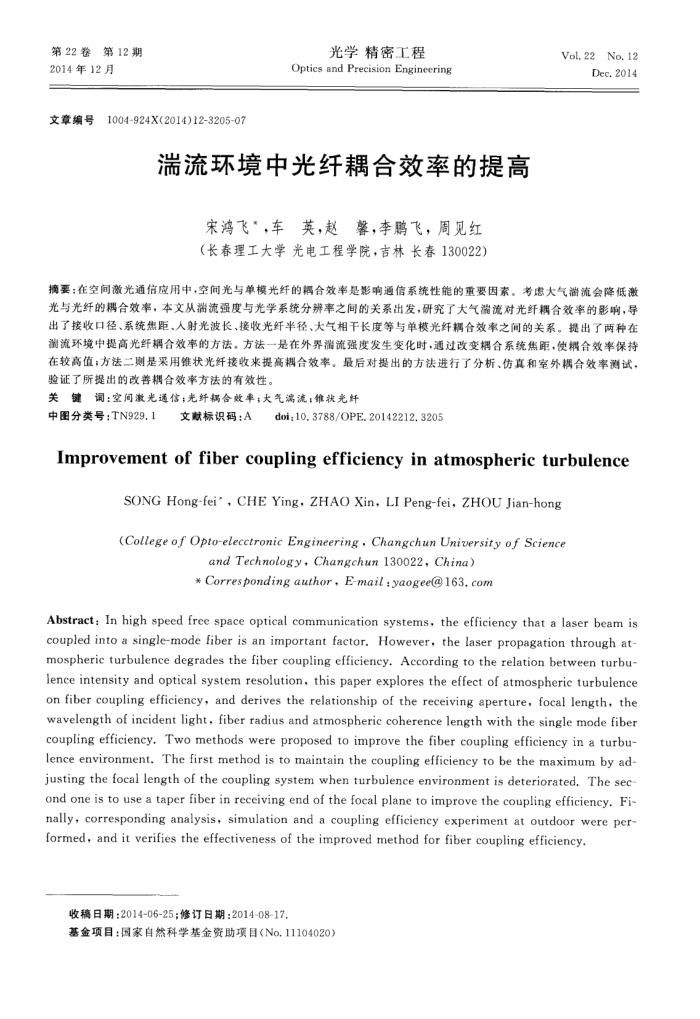您当前的位置:首页>论文资料>湍流环境中光纤耦合效率的提高
内容简介
 第22卷第12期 2014年12月
第22卷第12期 2014年12月1004-924X(2014)12-3205-07
文章编号
光学精密工程
Optics and Precision Engineering
瑞流环境中光纤耦合效率的提高
宋鸿飞*,车英,赵馨,李鹏飞,周见红(长春理工大学光电工程学院,吉林长春130022)
Vol. 22No. 12
Dec. 2014
摘要:在空间激光通信应用中,空间光与单模光纤的耦合效率是影响通信系统性能的重要因索。考虑大气淄流会降低激光与光纤的耦合效率,本文从端流强度与光学系统分辨率之间的关系出发,研究了大气滞流对光纤耦合效率的影响,导出了接收口径、系统焦距、人射光波长、接收光纤半径、大气相干长度等与单模光纤耦合效率之间的关系。提出了两种在潮流环境中提高光纤耦合效率的方法。方法一是在外界瑞流强度发生变化时,通过改变耦合系统焦距,使耦合效率保持在较高值;方法二则是采用锥状光纤接收来提高耦合效率。最后对提出的方法进行了分析、仿真和室外耦合效率测试,验证了所提出的改善耦合效率方法的有效性。
关键调:空间激光通信;光纤耦合效率;大气漓流;维状光纤
中图分类号:TN929.1
文献标识码:A
doi;10,3788/OPE.20142212.3205
Improvement of fibercoupling efficiencyin atmospheric turbulence
SONG Hong-fei',CHE Ying,ZHAO Xin,LI Peng-fei,ZHOU Jian-hong(College of Opto-elecctronic Engineering,Changchun University of Science
and Technology,Changchun130022,China)*Correspondingauthor,E-mail:yaogee163.com
Abstract: In high speed free space optical communication systems, the efficiency that a laser beam is coupled into a single-mode fiber is an important factor. However, the laser propagation through at mospheric turbulence degrades the fiber coupling efficiency. According to the relation between turbu-lence intensity and optical system resolution, this paper explores the effect of atmospheric turbulence on fiber coupling efficiency, and derives the relationship of the receiving aperture, focal length, the wavelength of incident light, fiber radius and atmospheric coherence length with the single mode fiber coupling efficiency. Two methods were proposed to improve the fiber coupling efficiency in a turbu-lence environment. The first method is to maintain the coupling efficiency to be the maximum by ad-justing the focal length of the coupling system when turbulence environment is deteriorated. The sec ond one is to use a taper fiber in receiving end of the focal plane to improve the coupling efficiency. Fi-nally, corresponding analysis, simulation and a coupling efficiency experiment at outdoor were per-
formed, and it verifies the effectiveness of the improved method for fiber coupling efficiency. 收稿日期:2014-06-25;修订日期:2014-08-17.
基金项目:国家自然科学基金资助项目(No.11104020)